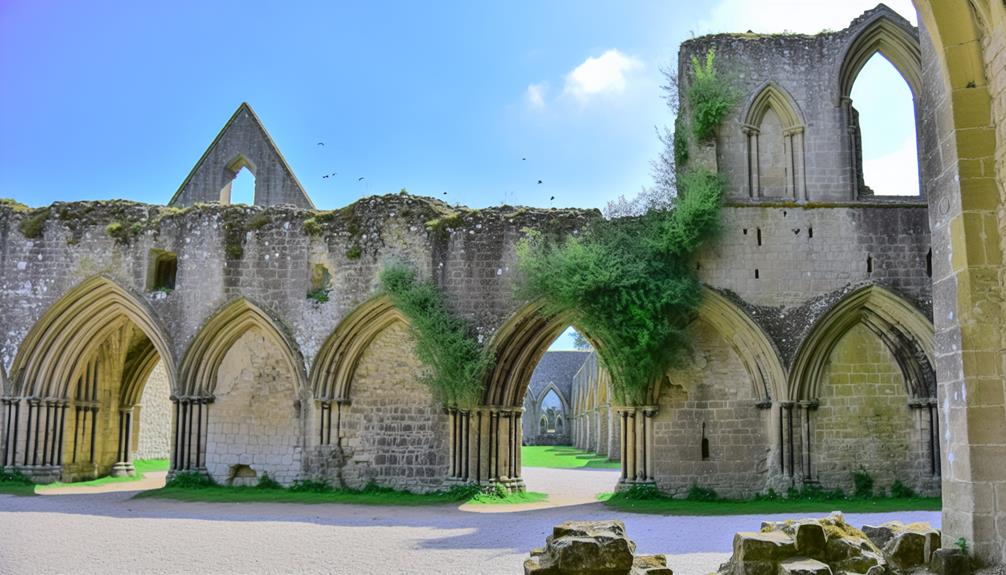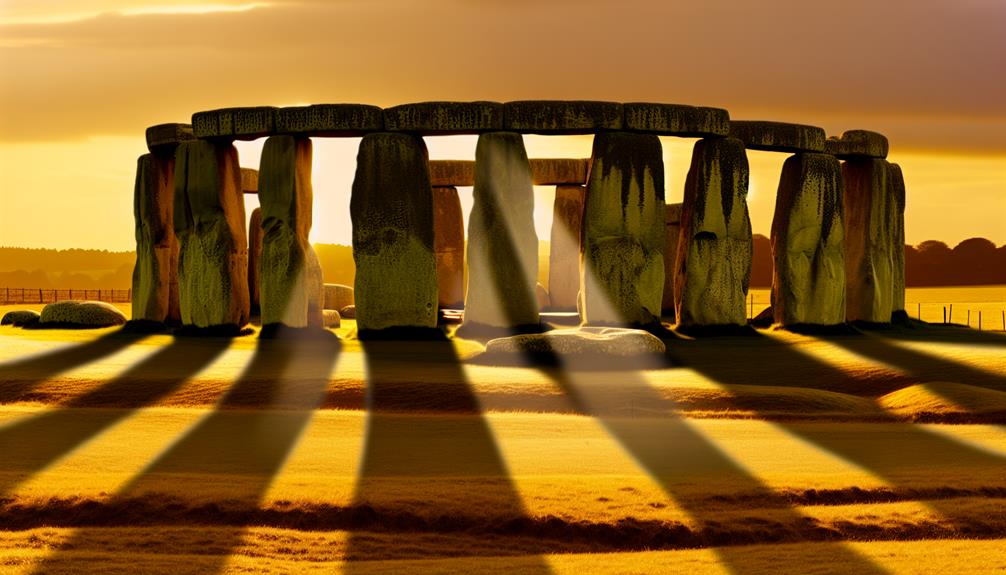Nestled in the historic town of Glastonbury, UK, Glastonbury Abbey's ancient walls whisper tales of centuries past, drawing visitors into its enigmatic embrace. Steeped in myth and legend, the abbey's storied past reveals a tapestry of intrigue and spiritual allure. From the enigmatic burial site of King Arthur to the graceful blend of architectural styles, Glastonbury Abbey stands as a timeless confirmation to a bygone era. As visitors wander through its hallowed grounds, a sense of reverence and curiosity intertwines, beckoning them to uncover the mysteries that lie within its sacred confines.
Key Takeaways
- Historic site dating back to 7th century.
- Burial place of King Arthur and Queen Guinevere.
- Blend of Norman and Gothic architecture.
- Popular for spiritual retreats and pilgrimages.
- Surrounded by peaceful gardens for reflection.
History of Glastonbury Abbey
With roots dating back to the 7th century, the history of Glastonbury Abbey is a remarkable demonstration of the enduring legacy of religious and cultural significance in the United Kingdom. The abbey was a center of spiritual significance, believed to be the site of the earliest Christian foundation in Britain. Over the centuries, it became a place of pilgrimage and prayer, attracting visitors seeking solace and connection to the divine.
Glastonbury Abbey housed a rich collection of medieval relics, including the tomb of King Arthur and Queen Guinevere, making it a focal point for Arthurian legend enthusiasts. The abbey's historical importance extended beyond its religious functions; it played an essential role in the development of English Christianity and culture.
The spiritual significance of Glastonbury Abbey was not only tied to its relics but also to the myths and legends that surrounded the site. Its reputation as the Isle of Avalon, a place where the veil between the earthly and spiritual worlds was thin, added to its allure. Pilgrims from far and wide journeyed to the abbey seeking healing, enlightenment, and a deeper connection to the divine.
Legends and Myths Surrounding the Abbey
Legends and myths enveloping Glastonbury Abbey have woven a tapestry of intrigue and mystique, adding layers of enigmatic allure to its historical significance. The site's rich tapestry of folklore tales and ancient legends has captivated visitors for centuries. One of the most famous legends surrounding the Abbey is the story of King Arthur and Queen Guinevere, who are said to have been buried on the grounds. This tale has fueled the imaginations of many, drawing them to the Abbey in search of the truth behind the myth.
Supernatural encounters and mysterious happenings have also been reported at Glastonbury Abbey, further shrouding the site in mystery. Visitors have claimed to witness ghostly apparitions and unexplained phenomena, adding to the aura of mysticism that surrounds the Abbey. These accounts have contributed to the Abbey's reputation as a place where the veil between the physical world and the spiritual domain is thin.
The Abbey's association with figures from Arthurian legend, coupled with the reports of supernatural occurrences, has solidified its status as a place of historical significance and intrigue. Whether delving into the depths of folklore or seeking out the truth behind reported sightings, Glastonbury Abbey continues to fascinate all who are drawn to its enigmatic charm.
Architecture and Features of the Abbey
The architectural design of Glastonbury Abbey showcases a blend of Norman, Early English Gothic, and later medieval styles, reflecting the evolving history and influences that have shaped the structure over the centuries. The abbey's structural layout is characterized by its grandeur and intricate detailing, typical of the Gothic architectural style. The pointed arches, ribbed vaults, and flying buttresses are prominent Gothic details that adorn the abbey, creating a sense of verticality and lightness within the interior spaces.
One of the most striking features of Glastonbury Abbey is the Lady Chapel, built in the Early English Gothic style. The chapel's slender columns, pointed arches, and large windows exemplify the elegance and refinement of this architectural period. The chapter house, with its intricate tracery and decorative carvings, is another highlight of the abbey's architecture, showcasing the skilled craftsmanship of the medieval masons.
As visitors explore the abbey, they can admire the remnants of the cloisters, where monks once walked in reflection, surrounded by the peaceful ambiance of the enclosed garden. The abbey's architectural features not only reflect the religious significance of the site but also serve as a tribute to the craftsmanship and artistry of the builders and artisans who contributed to its construction over the centuries.
Famous Burials at the Abbey
Numerous notable individuals have been interred within the sacred grounds of Glastonbury Abbey, adding a layer of historical significance to the site. The Abbey's grounds serve as the final resting place for a diverse array of historical figures, including kings, queens, and other prominent personalities.
Here are some of the famous burials at Glastonbury Abbey:
- King Arthur: The legendary King Arthur is said to have been buried at Glastonbury Abbey. His burial site, discovered in the 12th century, further solidified the Abbey's reputation as a place of myth and legend.
- Queen Guinevere: According to some accounts, Queen Guinevere, the wife of King Arthur, was also laid to rest at the Abbey. Her presence adds to the mystique surrounding the site.
- Edmund Ironside: King Edmund Ironside, who ruled England briefly in the early 11th century, was buried at Glastonbury Abbey. His tomb is a testimony to the Abbey's importance during medieval times.
- Thomas Wolsey: Cardinal Thomas Wolsey, a key figure in the court of King Henry VIII, was interred at the Abbey following his fall from grace. His burial at Glastonbury Abbey reflects the Abbey's significance as a religious and political center.
These royal tombs and the resting places of other historical figures make Glastonbury Abbey a site of pilgrimage and reverence for those interested in British history and folklore.
Glastonbury Abbey Today
The historical significance of Glastonbury Abbey transcends its past burials, as its contemporary role and presence continue to attract visitors and scholars worldwide. Today, the abbey stands as a confirmation to ongoing restoration efforts aimed at preserving its architectural heritage. The current restoration projects not only guarantee the longevity of this sacred site but also provide insight into medieval building techniques and craftsmanship.
Moreover, Glastonbury Abbey has evolved into a popular destination for spiritual retreats. Nestled amidst serene gardens and ancient ruins, the abbey offers a tranquil setting for individuals seeking solace and reflection. The peaceful ambiance and historical aura of the abbey create a conducive environment for spiritual contemplation and meditation.
Visitors to Glastonbury Abbey can witness firsthand the meticulous restoration work underway, gaining a deeper appreciation for the dedication and expertise required to maintain such a venerable structure. The blend of past and present at the abbey offers a unique opportunity for guests to engage with history while supporting ongoing conservation efforts.
Visiting Glastonbury Abbey
With its rich historical significance and serene ambiance, Glastonbury Abbey invites visitors to immerse themselves in a unique blend of spirituality and history. As you explore this ancient site, there are several intriguing elements that add to the mystique and allure of Glastonbury Abbey.
- Secret Passages: While wandering through the abbey's ruins, keep an eye out for hidden passageways that whisper tales of monks and medieval life. These secret passages offer a glimpse into the past, allowing visitors to connect with the history of the abbey in a more intimate way.
- Ghost Stories: Legend has it that Glastonbury Abbey is haunted by spectral figures from centuries past. Whether you believe in ghosts or not, the ghost stories surrounding the abbey add an extra layer of intrigue to your visit. Keep your senses sharp as you walk through the ancient ruins; you may just catch a glimpse of something otherworldly.
- Guided Tours: To truly appreciate the history and significance of Glastonbury Abbey, consider joining a guided tour led by knowledgeable experts. These tours provide in-depth information about the abbey's past, architecture, and the legends that surround it, offering a deeper understanding of this sacred site.
- Peaceful Gardens: After exploring the abbey's ruins and hearing its tales, take a moment to relax in the peaceful gardens surrounding the site. These well-tended green spaces offer a tranquil retreat where you can reflect on your visit and soak in the spiritual atmosphere of Glastonbury Abbey.
Frequently Asked Questions
What Is the Significance of the Glastonbury Abbey Ruins?
The significance of ruins lies in their ability to provide a tangible link to the past, offering insights into historical events, architectural styles, and cultural practices.
Archaeological discoveries within ruins can reveal hidden treasures, illuminate ancient civilizations, and contribute to our understanding of human history.
Restoration efforts aim to preserve these remnants of the past, ensuring that future generations can continue to appreciate and learn from these valuable remnants of our collective heritage.
Are There Any Hidden Tunnels or Secret Passages in the Abbey?
Underground passages and historical mysteries have long fascinated explorers and historians alike. The allure of hidden tunnels and secret passages within ancient structures adds an element of intrigue and speculation to historical sites.
These enigmatic features often spark curiosity and prompt further investigation to uncover their purpose and significance. The existence of hidden passageways within historical landmarks contributes to the mystique and allure of these structures, inviting exploration and speculation into their hidden secrets.
Do Any Paranormal Activities or Ghost Sightings Occur at the Abbey?
Paranormal investigations and ghost tours are popular activities for those intrigued by the supernatural. Many historic sites attract visitors seeking encounters with the otherworldly. Reports of ghost sightings and unexplained phenomena often fuel curiosity and draw crowds.
Professional paranormal investigators use various tools and techniques to explore these claims, adding a layer of mystery and excitement to the experience. Ghost tours offer a unique opportunity to investigate the eerie and enigmatic world of the supernatural.
Can Visitors Participate in Any Spiritual or Meditation Activities at the Abbey?
Visitors seeking spiritual retreats or meditation workshops can engage in a variety of activities to enhance their inner focus and well-being. These offerings provide opportunities for individuals to explore different techniques, practices, and philosophies to deepen their spiritual connection or meditation practice.
Are There Any Annual Events or Festivals Held at Glastonbury Abbey?
Various annual events and festivals are held worldwide, celebrating music festivals, traditions, cultural celebrations, and history. These events serve to unite communities, showcase local talent, and preserve heritage. They offer a platform for artists, musicians, and performers to share their craft and engage with audiences.
Such gatherings often attract a diverse crowd, fostering a sense of belonging and appreciation for the rich tapestry of human culture and creativity.
Conclusion
In summary, Glastonbury Abbey stands as a representation of centuries of history and legend, embodying a tapestry of spiritual significance and architectural beauty.
The abbey's blend of Norman, Early English Gothic, and medieval styles creates an engaging environment for visitors to explore.
Like a phoenix rising from the ashes, Glastonbury Abbey continues to stand as a beacon of historical intrigue and conservation efforts, inviting guests to explore the mysteries of its past and present.


